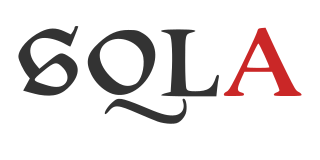| Original author(s) | Ian Bicking |
|---|---|
| Developer(s) | Oleg Broytman |
| Initial release | October 2002 [1] |
| Stable release | 3.10.2 / August 9, 2023 [2] |
| Written in | Python |
| Operating system | Cross-platform |
| Type | Object-relational mapping |
| License | LGPL |
| Website | sqlobject |
SQLObject is a Python object-relational mapper between a SQL database and Python objects. It is experiencing community popularity, and forms a part of many applications (e.g., TurboGears). It is very similar to Ruby on Rails' ActiveRecord in operation in that it uses class definitions to form table schemas, and utilizes the language's reflection and dynamism to be useful.
SQLObject supports a number of common database backends: included in the distribution are MySQL, PostgreSQL, SQLite, Sybase SQL Server, MaxDB, Microsoft SQL Server and Firebird.
The first version of SQLObject was publicly released in October 2002. [1]

Microsoft Access is a database management system (DBMS) from Microsoft that combines the relational Access Database Engine (ACE) with a graphical user interface and software-development tools. It is a member of the Microsoft 365 suite of applications, included in the Professional and higher editions or sold separately.

PostgreSQL, also known as Postgres, is a free and open-source relational database management system (RDBMS) emphasizing extensibility and SQL compliance. It was originally named POSTGRES, referring to its origins as a successor to the Ingres database developed at the University of California, Berkeley. In 1996, the project was renamed to PostgreSQL to reflect its support for SQL. After a review in 2007, the development team decided to keep the name PostgreSQL and the alias Postgres.
Structured Query Language (SQL), is a domain-specific language used in programming and designed for managing data held in a relational database management system (RDBMS), or for stream processing in a relational data stream management system (RDSMS). It is particularly useful in handling structured data, i.e., data incorporating relations among entities and variables.

Db2 is a family of data management products, including database servers, developed by IBM. It initially supported the relational model, but was extended to support object–relational features and non-relational structures like JSON and XML. The brand name was originally styled as DB/2, then DB2 until 2017 and finally changed to its present form.
Mimer SQL is a proprietary SQL-based relational database management system produced by the Swedish company Mimer Information Technology AB, formerly known as Upright Database Technology AB. It was originally developed as a research project at the Uppsala University, Uppsala, Sweden in the 1970s before being developed into a commercial product.

PyQt is a Python binding of the cross-platform GUI toolkit Qt, implemented as a Python plug-in. PyQt is free software developed by the British firm Riverbank Computing. It is available under similar terms to Qt versions older than 4.5; this means a variety of licenses including GNU General Public License (GPL) and commercial license, but not the GNU Lesser General Public License (LGPL). PyQt supports Microsoft Windows as well as various kinds of UNIX, including Linux and MacOS.
Kexi is a visual database applications creator tool by KDE, designed to fill the gap between spreadsheets and database solutions requiring more sophisticated development. Kexi can be used for designing and implementing databases, data inserting and processing, and performing queries. It is developed within the Calligra project but is released separately.
In computing, a solution stack or software stack is a set of software subsystems or components needed to create a complete platform such that no additional software is needed to support applications. Applications are said to "run on" or "run on top of" the resulting platform.
CherryPy is an object-oriented web application framework using the Python programming language. It is designed for rapid development of web applications by wrapping the HTTP protocol but stays at a low level and does not offer much more than what is defined in RFC 7231.

Django is a free and open-source, Python-based web framework that follows the model–template–views (MTV) architectural pattern. It is maintained by the Django Software Foundation (DSF), an independent organization established in the US as a 501(c)(3) non-profit.

LAMP is an acronym denoting one of the most common software stacks for many of the web's most popular applications. However, LAMP now refers to a generic software stack model and its components are largely interchangeable.

TurboGears is a Python web application framework consisting of several WSGI components such as WebOb, SQLAlchemy, Kajiki template language and Repoze.

SQLAlchemy is an open-source SQL toolkit and object-relational mapper (ORM) for the Python programming language released under the MIT License.
Microsoft SQL Server is a proprietary relational database management system developed by Microsoft. As a database server, it is a software product with the primary function of storing and retrieving data as requested by other software applications—which may run either on the same computer or on another computer across a network. Microsoft markets at least a dozen different editions of Microsoft SQL Server, aimed at different audiences and for workloads ranging from small single-machine applications to large Internet-facing applications with many concurrent users.
Embarcadero Technologies, Inc. is an American computer software company that develops, manufactures, licenses and supports products and services related to software through several product divisions. It was founded in 1993, went public in 2000 and private in 2007, and became a division of Idera, Inc. in 2015.
An embedded database system is a database management system (DBMS) which is tightly integrated with an application software; it is embedded in the application. It is a broad technology category that includes:
Google App Engine is a cloud computing platform as a service for developing and hosting web applications in Google-managed data centers. Applications are sandboxed and run across multiple servers. App Engine offers automatic scaling for web applications—as the number of requests increases for an application, App Engine automatically allocates more resources for the web application to handle the additional demand.
Web2py is an open-source web application framework written in the Python programming language. Web2py allows web developers to program dynamic web content using Python. Web2py is designed to help reduce tedious web development tasks, such as developing web forms from scratch, although a web developer may build a form from scratch if required.
Storm is a Python programming library for object-relational mapping between one or more SQL databases and Python objects. It allows Python developers to formulate complex queries spanning multiple database tables to support dynamic storage and retrieval of object information.
Pylons Project is an open-source organization that develops a set of web application technologies written in Python. Initially the project was a single web framework called Pylons, but after the merger with the repoze.bfg framework under the new name Pyramid, the Pylons Project now consists of multiple related web application technologies.